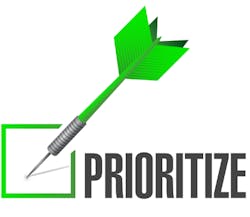Teaching dental office staff how to prioritize
At a recent speaking event, a new dental office staff member asked me something I’d never been asked before. The question threw me off because it wasn’t easy to answer, and there was no obvious answer. When I went back to my office on Monday, and since I have new employees on my team right now, I realized the question would be a great topic to share.
An employee new to the world of dentistry asked, “How do you know what to do, and in what order? How do you know what to prioritize?” She wasn’t asking me whether should she complete confirmation calls before calling insurance, or about the order of her daily duties in her office. She was asking about the judgement call someone needs to make when they have seven things going on at once, with patients are looking at them, the schedule falling apart, and the phone ringing.I’m having a similar experience with new employees in my office. I think this is a really hard question to answer. It’s not obvious to everyone what to do and in what order things should be completed. Not everyone has innate troubleshooting skills or decision-making skills. If employees are not told what you expect of them, they will do the best they can, but their decisions may not be the same as yours, or may not be what you expect from your office staff.
How do you train your dental office employees to prioritize?
First, it’s really important that you have regular conversations and provide feedback to your employees. These regular communications will help them when everything comes up at once and you expect them to make the right decision regarding what to do. After talking to one of my new employees about this issue, what we determined was that when someone is having to make decisions, they need to start by figuring out the following.
● What can have the biggest impact? The items that will have the biggest impact are those things that need to be handled right now, to keep today’s schedule together and to make sure patients who are in the office are being handled. We want to do whatever we can not to let the day fall apart, and that takes priority over issues that affect next week’s schedule.
● What’s going to have the most immediate impact? If you have four or five things that need handling, you need to determine what is going to take the most versus the items you can check off the list the quickest. Let’s say you have to decide between calling an insurance company versus making calls to confirm tomorrow’s patients. It’s going to be faster to make the confirmation calls, and it’s going to make a bigger impact on the daily schedule. However, if you’ve got a patient in today’s schedule in the chair right now and you’re trying to verify benefits, call the insurance company as this is a priority over tomorrow’s schedule.
● What is going to be the easiest or the hardest to solve? If the impact and time commitment are the same, how many steps will it take you to complete a task? Do you need to speak with the doctor, or call the insurance company, or check with a team member? The item with the least number of steps should be completed first.
ALSO BY LAURA HATCH
Why your dental office should consider a membership club
How important is the first day for your new dental employee?
Is your dental office insurance driven, or insurance savvy? There's a big difference
Secondly, as a dental practice owner or office manager, you have to recognize that not every employee has these innate skills. Not everyone you hire is going to know how to make the right decision at the right time. It’s hard to train new employees or to incorporate this into your employee manual because each and every day in a dental office is completely different, and each and every minute in a dental office has different variables and challenges.
You can’t write it down and say if this happens do this first, and if this happens do this second. Decisions have to be made on the fly and you need to make smart decisions. It’s important to help current and new employees recognize when they made the right decision so they know that they're doing well. If they made an incorrect decision give them quick feedback so you can keep the day moving in the right direction. Be prepared to discuss the incorrect decision in more detail at a more appropriate time.
Lastly, one thing I can say when you have this discussion is, do not make employees wrong when you ask them how they came to their decision. Recognize the fact that they made a decision, because that's much better than somebody always coming to you and asking you how or when to do something. Ask them how they came to their decision because it's important to hear their thought process, and it’s important to acknowledge that thought process because it made sense to them. Then explain why they should have taken a different course of action.
When your employees receive immediate feedback and two-way communication, they feel respected and acknowledged. They will be more willing to grow and learn to adapt to the way you want your office to be run. The worst mistake you can make is to become frustrated with someone or leave them alone. Then you’ll have an employee not trained well and doing things in the wrong order.
For the most current office manager headlines, click here.
For the most current dental headlines, click here.
About the Author

Laura Nelson, MS, FAADOM
Founder of Front Office Rocks
Laura Nelson, MS, FAADOM, is the founder of Front Office Rocks, which provides an online training platform that delivers 24/7 educational resources, focusing on improving team efficiency and customer satisfaction. Laura cofounded Sober Life Rocks, which encourages sober choices at industry events. She wrote two books, Step Away from the Drill and Hiring without Hesitation, which share her strategies for excellence in practice management. Laura’s presentations and dedication to her field make her an inspiring speaker at dental conferences and seminars.
Updated April 29, 2024

